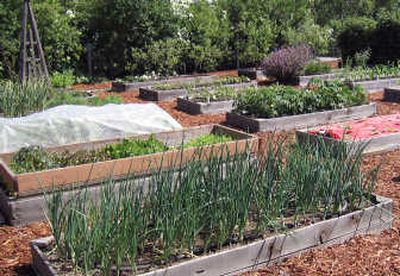In the Garden: Call of the veggies

Finally! It’s time to talk about planting vegetables. For three weeks, we’ll look at crops that get started early in the season, usually as soon as the soil can be worked.
Onions
Onions can be grown from seeds, plants, or “sets,” which are small bulbs. They are all easy to grow and should be watered regularly throughout the summer. Plant the seeds 1/4-inch deep in rows 12 inches apart. Thin them to three inches apart within each row. Onion plants produce the most quickly of the three types: they are ready in four weeks as scallions and as full-sized bulbs in about four months. Walla Walla Sweets are the most commonly sold plants.
Yellow, red or white onion sets are widely available and also mature quickly. Plant them about two inches deep, four inches apart in rows spaced 12 inches apart. During the summer, harvest every other onion to use as scallions, leaving room for the remainder to grow into large bulbs. No matter whether you started with seeds, plants or sets, they all get the same treatment in late summer: when the stems fall over, pull up the onions and dry them in a warm area out of direct sunlight before storing them. Don’t let them get wet during this period.
Shallots
Shallots have been a delightful discovery for us. You might think they’re just like onions but once you sauté them in butter and taste their sweet flavor, you will want to reserve a spot for them in your garden every year. Plant them just like onion sets. Shallots produce a cluster of bulbs for each set you plant so you really get your money’s worth. Harvest them throughout the summer or late in the season when the tops fall over, and dry them like onions.
Carrots
Carrot seeds are slow to germinate, taking 14 to 21 days. Since carrot sprouts are kind of wimpy, I like to cover them with 1/4 inch of seed-starting mix or peat moss to make it easier for the seedlings to push through the surface. Plant the seeds in rows spaced about four inches apart. Once the seedlings are about three inches tall, thin them so they are three inches apart. I must emphasize that thinning your seedlings is the key to success with carrots. Also, don’t over-fertilize them – or any root crops, for that matter – or they will develop forked roots. You can start harvesting carrots once they are about 1/2 inch in diameter. Reliable varieties include Danvers half-long, scarlet nantes and Kuroda.
Radishes
Radishes are fun to grow because they are one of those instant-gratification crops. These guys germinate very quickly and mature in 22 to 30 days. Because of their speedy germination, I often plant them to mark the location of a row of slow-to-germinate seeds or mark the boundary between different varieties. Plant radish seeds 1/2-inch deep and space them three inches apart. Radishes can get pretty spicy and pithy when hot weather arrives, so harvest them fairly early in the season. Fun varieties include Easter egg (pastel colors) and Misato rose hybrid (white edges with pink centers).
‘Grow your own food’ classes
A series of classes sponsored by WSU Spokane County Master Gardeners begins soon. Topics are “Vegetables and Heirloom Varieties” (April 17), “Raised-Bed Gardening” (April 24), “Growing Fruits and Berries” (May 1), and “Growing and Using Culinary Herbs” (May 8). They will be held from 6 to 8 p.m. at the Spokane County Extension Center, 222 N. Havana St. Classes cost $10 each or $35 for the series. Call (509) 477-2048 to register.